After another harrowing week of violence, I sat down at my computer to attempt to “work.” Or to just do something, anything. But I continued to scroll, watch, or listen to terrible things.
Then, I received an email from a beloved colleague. The bolded subject line: “Dr. Briscoe-Smith can you help any advice about how to talk to children of color about these massacres?”
My first reaction was simply “Nope. Why you askin’ me?” Just that afternoon I had hurriedly turned off the talk radio station as my son entered the car. I had quickly put down my phone as I felt my daughter looking over my shoulder at the images on my Instagram feed.
I was yet again seeing images of violence against black bodies, bodies like my own and like my children’s. There was overwhelming pain, grief, and rage. This wasn’t new—just another wave of what I’ve known my whole life. But now I could hold the murder of those like me in my hand, and it could be watched over and over again. It was in front of my children, as well. In all of this, I found myself exhausted.
But here I was being asked for help. I had to remind myself of why people might be turning to me. I did something silly and stupid: I Googled my name and “violence” (pro tip: Don’t do that). I got a list of my previous webinars and articles. Since around 2009, I’ve been writing and speaking about how trauma impacts kids; how children understand race and racism; how to talk with children about grief, terror, racialized violence; and how to promote resilience. That’s 10 years talking about pretty much the same damn thing.
Going over those talks was a good reminder about the sound science, evidence, and wisdom that we all have available to us about how to survive after terrible things—and how we as parents, teachers, and caregivers can support children. As I reread and reheard my own words, however, I felt a growing sense of disquiet.
In a December 2012 radio interview, there was a cheerful optimism in the tone of Dr. Briscoe-Smith. I heard myself saying that surely urban violence and school shootings would spur a change in gun laws. In recorded talks after Oscar Grant, after Tamir Rice, after Ferguson, after Philando Castile, I seemed to feel, all those years ago, a dogged commitment to the absolute fact that our “better angels” would prevail. By 2016, I heard from myself a renewed focus on our resilience and capacity to overcome our differences. And during the summer of Charleston in 2017, there was in my voice a buoyant hope for possible change.
Over and over, I heard myself say things like “We must talk to our children” or “Remember, we are resilient.” Today, frankly, those feel like words spoken by someone else. If I am honest, right now, I am tired, I am discouraged, and I feel impotent to affect my world for the better. I feel like I am getting so used to terrible things that I can scroll past them with a hesitation, offering a quick “thought and prayer” before moving on. I teeter between being numb and overwhelmed with the state of the world.
I know I am not alone in these feelings.
On an intellectual level, I have fiercely held on to a deep belief that we—as a people, as Americans and African Americans—have overcome hatred, divisiveness, dehumanization, and violence before. I believe that we must remember the stories of resilience and strength within our own families in order to effect change today. When I hear people talk about how definitively worse things are now than “ever,” I bristle. I simply refuse to believe that is true. By so many empirical measures, life is “better” now. We’re living longer, we have more access to health care, there’s less crime. But still the sentiment that I so often encounter is that this is different and worse, somehow.
 The author's mother, Agatha "Aggie" Briscoe, in 1976.
The author's mother, Agatha "Aggie" Briscoe, in 1976.
In fact, I even argued with my mother about this. She was lamenting how terrible things are. “C’mon, Mom,” I said. “With all that you’ve been through—Jim Crow in the south, civil rights, Vietnam, poverty, discrimination—that had to be worse.”
To which she replied: “No, it wasn’t. It was bad, but I thought we’d be further by now, that it would be different by now, that we wouldn’t be hurting each other like this by now. And that makes it hurt more.”
My mother is a black woman who grew up with her five siblings in the deep South during Jim Crow. Her first toy was a “Mr. Potato Head” that was an actual potato. She looked like Angela Davis back in the day, as a college student at UCLA, and was routinely harassed for it. She married a Vietnam vet with intense post-traumatic stress disorder. So, yeah, she’s been through it, and her baseline for suffering is pretty high. So, when Mom says that things are worse now, I have to listen. And if I’m honest, things do feel different now. I was arguing with her, based on my convictions, but in my heart, I knew she was right.
I study trauma, and so I look to the scientific literature on trauma to understand my own experience. “Psychological trauma is an affliction of the powerless,” writes Harvard psychologist Judith Herman in her classic book Trauma and Recovery. She continues:
At the moment of trauma, the victim is rendered helpless by overwhelming force. When the force is that of nature, we speak of disasters. When the force is that of other human beings, we speak of atrocities. Traumatic events overwhelm the ordinary systems of care that give people a sense of control, connection, and meaning.
She also states, “The knowledge of horrible events periodically intrudes into public awareness but is rarely retained for long.” This gets to the core of why things might feel different now. The intrusions are not periodic anymore. Instead, there is now the constant witnessing and proximity to multiple, repeated, and horrific disasters and atrocities. We all know that many communities have always experienced high levels of trauma. For them, there was never such thing as “the periodic.” Even there, however, things are different now. Let me share a personal example.
Last summer, several nights after yet another series of mass shootings, I went out to dinner with a dear friend in downtown Oakland. It was a local spot, with diverse and lively families sitting around us. Toward the end of the evening, we heard a pop pop pop. And then more, pop, pop, pop—and then someone yelled, “Get down!” We dropped to the floor of the restaurant, the friend and I looking at each other in disbelief. Most of the crowded restaurant was on the floor with us. “What’s happening?” “Stay down, stay down!” “Is this really happening?” There was such confusion, such fear, such disbelief at the same time.
I can’t tell you whether this was for 30 seconds or five minutes. I grabbed my friend and started crawling on the floor toward an exit. Several folks were on the phone, calling 911. Then as I was crawling my way out, someone came in and said, “It’s OK, it’s OK, they’re gone now.” A woman stood up and balled up her fists, shaking, “Who did this?” Several people ran out, one couple remained frozen, the fork still halfway to the woman’s mouth. Dishes were spilled on the floor and a mother held her weeping teen daughter. Someone said, “These are the times we live in.”
Now, the thing is, this happened in a community that is not unused to violence. This happened in Oakland, on a street where pop pop pops aren’t unusual. They usually mean a drive-by, and it’s horrible. I hate to say it, but many of us are used to this, and we know what to do. But this was different. A stray bullet and a targeted one can have the same impact, but this felt worse, somehow, from all the other incidents. I have been in spaces before with a pop pop pop and we never responded like that, never collectively like that before. Things have been bad, but we were all on a hair trigger. We were hypervigilant—and hypervigilance is one of the signs of post-traumatic stress disorder.
It is hard for me to say this, because I cling desperately to hope. But as I am witness to another towering wave of racialized violence, on top of a global pandemic, I find myself sinking into depths of rage, overwhelm, and even numbness. To combat these feelings, I feel compelled to speak up. These days, I am doing speaking engagement after speaking engagement at a manic pace. I reply to emails like the one from my friend, asking me to help them talk to their children about what’s happening.
All this talking about trauma and race brings me back to my mother. I can’t remember a single thing my mother has ever “said” about race. My father was the one who told the stories, who gave the lectures, who gave me the “talk.” But I know it is also my mother who has taught about race. About who a black woman can be, about how to deal with sexism and racism.
She also taught me about hope. She didn’t do this in words. My mother is almost pathologically positive and kind. She sees the best in others. She knows herself well and she is deeply connected to others—and she’s the safe place I return to. She has helped me weather the storms of my youth. It’s not that she has been silent about how to overcome grief, trauma, and sadness—it’s just that I remember her “way” more than her words. She didn’t ignore what was going on. I remember her having the full range of emotions when I was a child: anger, rage, sadness, grief. While I know I didn’t see or appreciate her feelings, she didn’t shield me from them, either. I’ve studied in academic settings how to talk with kids about race, violence, and trauma, but I got my most important lesson about these things from Mom: We don’t need to say the perfect words, and we don’t have to be the perfect parent who is positive all the time, to support our children. We can be, and should be, as human as we feel.
In this midst of all this anger—in the face of mass shootings, racist violence, a global pandemic—I again returned to my mother. I wanted her to soothe me with how things were “so much better now,” but she gave me the truth—her truth. And because she hasn’t sugarcoated things in the past, I know I can trust her. I know that I have to listen to her. She has given herself the space to be sad, to worry. That gives me the space to do so, as well.
That’s the lesson I got from the School of Mom. As a psychologist, I have additional evidence-based advice for my friend and for adults like her who are taking care of children. Here are some things I think we need to keep in mind:
- It really is different now, due to the cumulative effects of chronic exposure to “viral” images, sounds, and the recounting of terror proliferated via the media channels of the internet, social media, radio, and TV.
- Solutions to natural disasters (like COVID-19) and human-made atrocities feel out of reach to the average person, which is causing more stress and fear.
- A generation of children with exposure to the internet and social media are consuming much larger, visual, and uncontrollable images of disaster and human-made atrocities, and it is having a negative impact.
- Caregivers who have been coping with ongoing stressors in this current era are stretched thin and in need of more support.
- And many of us are tired, so tired. It’s OK to be tired.
So, given that context, how do we keep talking with our children about terrible things that keep happening over and over again? Here are my suggestions:
- Check in with yourself. How you doin’? No, really. How are you, as a parent or caregiver, doing? How do you understand what is going on? How is it making you feel? Be honest with yourself. Before we focus on what we tell our kids, what do we tell ourselves? How are you staying well? And if you aren’t well—and many of us aren’t—how do you get some help?
- Filter what reaches your children as much as you can. If you’re feeling overwhelmed, just think about how your children—with so much less life experience and knowledge—might be feeling. While I still believe it’s important to talk to our children about the bad things going on in the world, I see that, if we are so lucky and privileged, we should still try to at least space out or filter the information that reaches them. The research says that the pervasive and chronic nature of mass and racialized violence—the exposure to images and sounds—is taking a toll on adults, and it’s affecting our kids, too. If we can break up the flow of violence and threat, we should.
- Commit to action. Any action. Even and especially if that action is a “small act of kindness.” Be a role model of proactive empathy and compassion.
- Listen to your children and support their actions. So much of the conversation about talking with our children is really about talking at our children. There’s a time for that, but try to first be curious about how they are doing, how they are making sense of things. Listen to them about how they understand what’s happening and what solutions they might like. We can support our children in leading without leaving them to clean up our messes. If they’re old enough to pursue solutions, encourage them to do so. If they want to march, just make sure they’re wearing a mask and bring a bottle of Purell. If they want to volunteer, help them to find a way.
- Draw their attention to the good things. The terrible things are important to pay attention to, but they do not have to dominate our existence in the way that they are now. Pay attention to moments of joy, too. If your attention goes to examples of heroism, helping, empathy, and resilience, your kids will follow your gaze, even if they don’t seem to be.
- Remember our stories of resilience. Let’s not forget: We have indeed been through terror and trauma before. Every family has a story of survival, of resilience. Let’s cultivate and tell those stories—and create new ones.
I am holding on desperately and painfully to hope that things will feel better soon. I needed a friend to remind me that we have been down this path before and we can survive together. That’s a gift I can give to my children, and that you can give to yours.
I don’t know if my children will remember anything that I’ve said about race. They’ve been to my talks, and soon will read my articles. But more than that, I hope they remember my way. As my mother has taught me, I don’t need to be positive all the time. I hope that I am showing my own children the full range of my humanity.
At its core, I think, racism is the inability to see the other—the “different”—as human. If my children can see the human in me, their black mother, they’ll be less likely to internalize the lie that racism tells them about us. That truth will, I hope, make them stronger in the face of all the terrible things we’re facing.
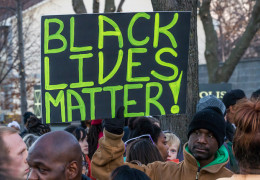

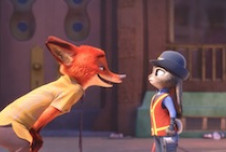

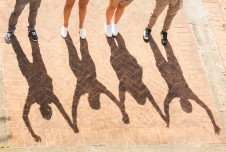
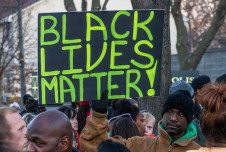
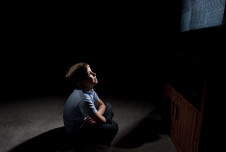

Comments